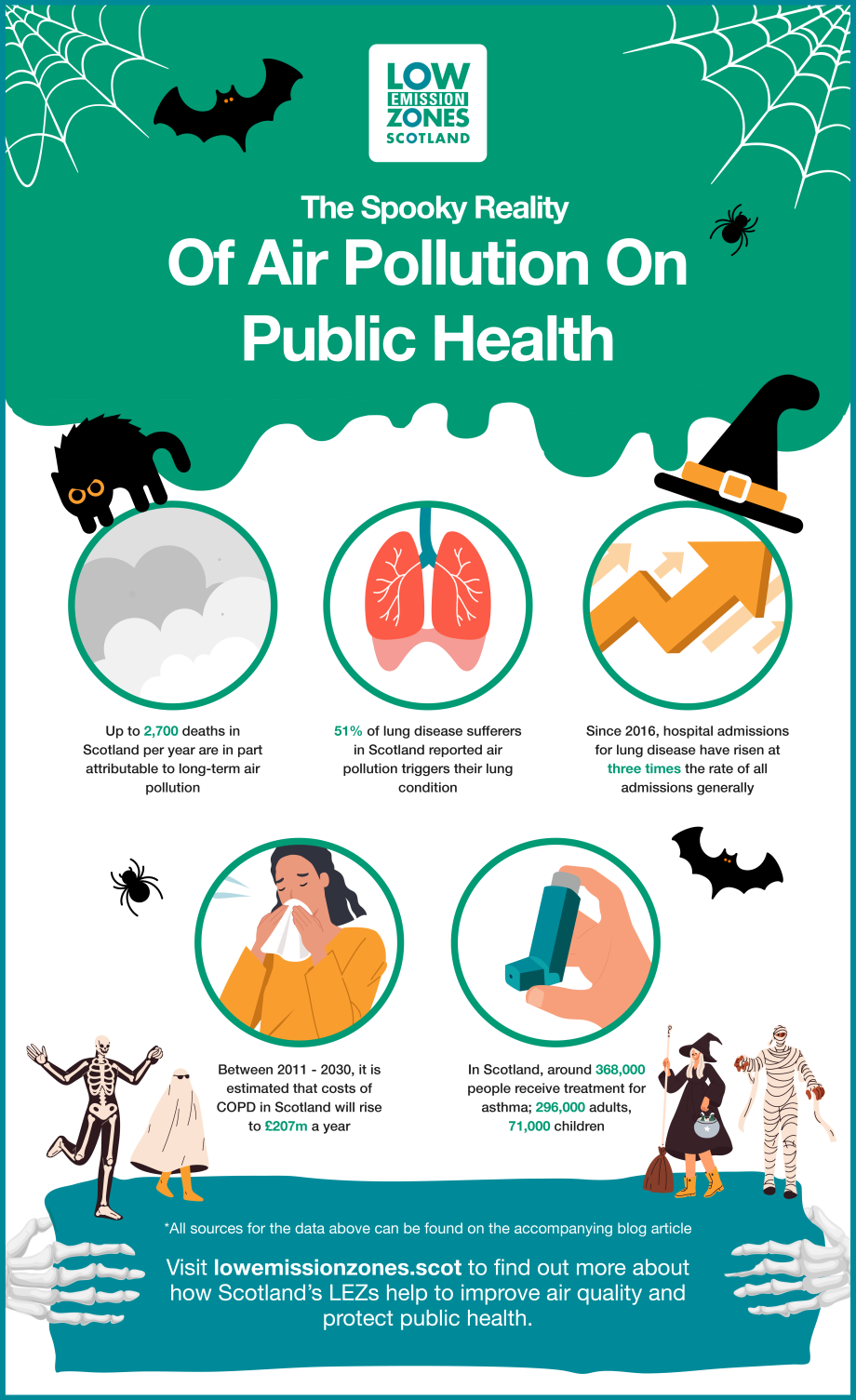The spooky reality of air pollution on public health

Halloween is a scary time of year, but one thing that has frightening consequences all year round is air pollution. Air pollution is detrimental to public health.
While Halloween typically conjures images of ghosts, ghouls, and things that go bump in the night, we invite you to delve into a different kind of spookiness – the eerie world of air pollution and its frightening consequences. In this blog, we’ll unearth the chilling, spine-tingling, and downright hair-raising facts about air pollution that will leave you terrified.
Ghosts in the air: the invisible pollutants
The air is filled with invisible pollutants that invisibly haunt us, with transport being the highest contributor.
Particulate Matter (PM) is tiny particles that come from vehicle exhausts, industrial processes, and natural sources. PM can reach deep into our lungs, causing respiratory issues and even heart problems.
Nitrogen Oxides (NOx) are emitted from vehicle engines and combustion processes. High levels of NOx combined with PM are associated with poor air quality.
These particles float in the air and enter our bodies when we breathe, meaning they impact on our health. In particular, they affect already vulnerable individuals, especially those with existing lung conditions and children whose lungs are still developing and are more easily damaged. Having a lung condition makes you more susceptible to harm from toxic air.
Monstrous effects on health
Air pollution costs the Scottish economy £1.1bn per year in days lost at work and costs to the NHS1 and is in part attributable to cutting short over 2,700 lives a year in Scotland.2
Air pollution is causing more people to develop lung conditions like asthma and lung cancer and worsening existing ones, with 51% of people in Scotland reporting that air pollution triggers their lung condition.3
With 1 in 5 Scots developing a lung condition like asthma and chronic obstructive pulmonary disease (COPD) in their lifetime, for them, air pollution can trigger life-threatening asthma attacks and exacerbate people’s symptoms.4
Since 2016, hospital admissions for lung disease have risen at three times the rate of all admissions generally4 which indicates that the rise in air pollution is linked to the rise in the number of people suffering from lung diseases. In Scotland, around 368,000 people receive treatment for asthma; 296,000 adults, and 71,000 children.5
Rates of lung disease are often higher in disadvantaged communities. Someone from the most deprived section of society is 2.5x more likely to have COPD, and nearly twice as likely to develop lung cancer as someone from the least deprived section of society.6
But it’s not just the lungs that are affected by air pollution; once Particulate Matter (PM) is in your body and your bloodstream, it can affect other areas of your body as well.
Air pollution can also lead to heart attacks, strokes, and high blood pressure. Long-term exposure can increase the risk of heart disease. Exposure to PM can damage blood vessels and cause them to become narrower, making it more difficult for your blood to flow freely, making your blood more likely to clot, and increasing your blood pressure because your heart is pumping faster to move the blood that can’t flow properly.7
If PM gets into your brain, it has been proven to affect your mental health and increase the risk of dementia and lead to a general decline in mental ability.8 Being exposed to air pollution is linked to mental health conditions such as depression and anxiety, which can lead to a poorer quality of life for sufferers.9
The phantom of climate change
Air pollution is not just a threat to human health; it's also a main driver of climate change. PM and NOx contribute to the warming of the planet, and air pollution plays a role in this sinister process.
Reducing air pollution can help combat climate change by lowering harmful pollutants in the air.
Climate change is having a huge effect on the planet and everyone must play their part in order to reduce the very real threat.
The curse of inaction
There are many ways people can help to reduce air pollution and everyone should look to make changes to their everyday lives in order to make a difference.
In terms of transport, thinking more about how to travel more sustainably is key. Choosing to walk, wheel, cycle, or use public transport as much as possible helps to reduce vehicle emissions and will reduce the numbers of vehicles on the road.
Low Emission Zones (LEZs) are key to helping to improve air quality in Scotland’s major cities. They are in place in Aberdeen, Dundee, Edinburgh and Glasgow and play a vital role in improving air quality by setting an environmental limit on certain city roads, and restricting access for the most polluting vehicles.
If Scotland’s air quality continues to get worse, it will put more people’s health at risk and potentially make things even worse for those who are already suffering with various health issues.
The spooky reality of air pollution on public health and the environment is a chilling reminder of the urgent need for us all to action. By embracing vital changes to the way we live and travel we can banish these ghosts and ghouls from our air, protect our health, and work towards a brighter, less frightening future. This Halloween let's choose treats over the trick of air pollution.
References
1 https://foe.scot/wp-content/uploads/2017/08/Air-Pollution-in-Scotland-FoES-MSP-briefing_0.pdf
3 Asthma + Lung UK’s 2023 Life with a Lung Condition survey
4 https://www.england.nhs.uk/ourwork/clinical-policy/respiratory-disease/
5 https://www.asthmaandlung.org.uk/scotland
7 https://www.bhf.org.uk/informationsupport/risk-factors/air-pollution
8 https://www.gov.uk/government/publications/air-pollution-cognitive-decline-and-dementia
